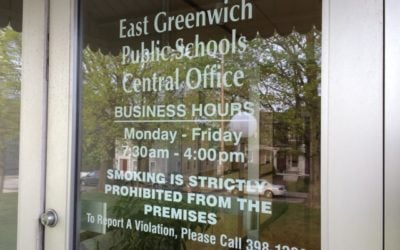By Eugene Quinn
Next week East Greenwich residents have a chance to approve a much-needed investment in our school and town infrastructure, with a $150 million school construction bond referendum on the ballot. As a retiree living on a fixed income, I have to be concerned about the impact on my property taxes.
I voted to approve the bond because I feel it is prudent for our community to make these improvements at this time. While you can debate the exact amounts, I’m convinced we will pay more and get less if we postpone these actions, because we will lose part of the state reimbursement, and construction costs are rising rapidly.
Prior to voting, I conducted a careful analysis of the impact on my taxes using the town’s projections. As a senior, it was important to factor in my age exemption. Since the town examples assumed no exemptions, I replicated my analysis for all residential properties as a public service.
It’s important to realize that the town examples are projecting the entire tax bill, of which debt service on the school bond is only a small part (5 to 11 percent depending on the year). Most of the projected increase is a result of growth in operating expenses that occur whether the bond is approved or not.
The town manager has stated that the estimates are conservative, so the actual increases are likely to be lower.
If you only look at the increases in the projected tax bills, it’s easy to get the impression that the tax impact of the bond is much greater than it is.
A good example of this is a website created by an EG resident where you enter your home’s assessed value and it tells you that if the bond passes, your 2030 and 2040 tax bills will be 27.68 percent and 53.83 percent higher, respectively, than your 2023 tax bill.
While consistent with the town projections, there is no allowance for exemptions and no mention of the fact that most of these increases occur whether the bond passes or not.
And while a 54 percent increase in your tax bill sounds very scary, it’s over 17 years so it’s equivalent to 2.6 percent growth per year, which is in line with historical trends.
Finally, if you look at the history of school bonds in East Greenwich, the one under consideration is about the same percentage of the tax base as the 1928 Eldredge and 1956 Cole bonds, and much less than the 1964 EGHS and Frenchtown bonds, which would be equivalent to more than $360 million with today’s tax base. Now that is truly a frightening number, but we made it work. Let’s continue that tradition on Nov. 7.
Eugene Quinn, a retired math professor, is a member of the East Greenwich School Committee.
Photo by Element5 Digital on Unsplash






 Subscribe
Subscribe
Hi All, I’m that “EG Resident”. I have great respect for Eugene and the service he has done for the town, but have to call out an inaccuracy. He says there is “no mention of the fact that most of these increases occur whether the bond passes or not”, yet right below the calculator output on egbond.com it says:
“Note: Some of the tax increase is due to the baseline projected budget and not the bond, though no firm plan B has been communicated. This site attempts to estimate the non-bond case under the assumption the town would still adopt the higher 3% growth rate in non-bond line items vs the 2% recent average.”
I link directly to his site there as well as another spot on the page. I understand his concern, and took similar feedback from him right after launch a month ago which prompted a few language adjustments to help clarity, but did not feel comfortable presenting a financial comparison to an unofficial plan B.
Kurt, sorry I missed the fact that you did mention that the increase was not entirely due to the bond. I appreciate the service you have provided the community with your website.
We’re all trying to make a good decision in a situation where doing nothing is not an option. We had to add temporary space at Hanaford this year, and we have millions of dollars in deferred maintenance.
In the itemized cost section of the web pages I built, I segregate expenses that have nothing to do with the school bond, and this is enough to establish that in fact most of the increase in the total tax bill is due to operating expenses and existing debt service.
I also wanted to provide tax bill estimates that include exemptions, which are important for people like me who are retired and living on a fixed income. For us, a tax bill computed from the full assessed value will be overstated. For the current year, senior exemptions range from $568 to $1718 depending on your age. This can be a significant fraction of the tax bill for less expensive homes and residential condos.
I agree that what I presented for the “bond rejected” scenario is not a true “Plan B”, but rather the status quo (mostly I just excluded debt service on the school bond). I was comfortable presenting it because one can argue that it is a floor for any actual “Plan B” costs.
Any true alternative plan has to involve new construction or renovation. Those costs will be difficult to estimate in an environment where construction costs are rapidly escalating (I’ve seen estimates of 11% per year; I will ask Colliers for a number).
As each year goes by, what you can build for a given cost decreases, and does so rather quickly.
Thanks Eugene. Perhaps a minor correction to the piece is warranted, but thats up to you.
I’d be curious to see what percentage the bond represents if you had used the more historically accurate 2% as the non-bond expense line items increases. Using 3% diminishes the bond impact on a percentage basis.
Likewise a large chunk of the increase in taxes will be from projected assessment increases, which my site breaks out and labels.
Two percent is a recent (2010) development, and is not sustainable:
Thank you for this information. The historic perspective helps. I am voting yes.
Thank you for such a detailed analysis, Eugene! And Kurt as well! It’s great to know we have residents really digging into the data that can be used to make thoughtful decisions. One quick question that I couldn’t figure out from the town’s data: the rate increases in 2027 (6.36%) and 2028 (5.11%) are a bit…intimidating. Are these increases only due to the bond or mostly driven by other planned investments? Thanks in advance.
Email Andy Nota and he can give you the best answer, but I believe it is just an artifact of the way some of the debt either rolls off the books or is taken on, combined with when money starts to arrive from the state.
Agree with Kurt. They have a number of options to smooth out the bumps, including use of fund balance in 2029-2031. I’m sure they will refine this as the details firm up.